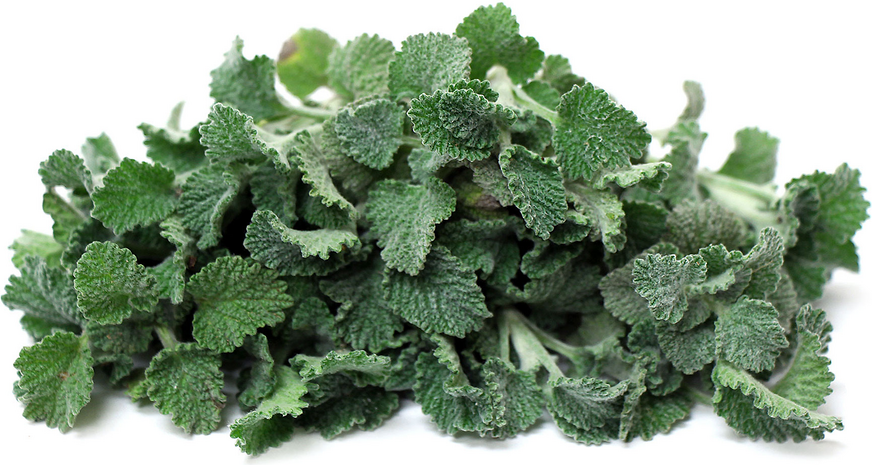


White Horehound
Estimated Inventory, lb : 0
Description/Taste
White Horehound is a small, bushy plant with thick, blocky stems that produce oval to round leaves, averaging 2 to 5 centimeters in length. The petite leaves are deeply creased and wrinkled with a coating of downy hairs, creating a soft, ridged, and textured consistency. The leaves also have a dark green appearance, dusted with silver hues, and bear bluntly serrated edges. White Horehound has a crisp and tender consistency with a musky, mineral-forward aroma. The herb is known for its bitter, tannic, and woodsy flavor mixed with fresh green nuances. In addition to the leaves, White Horehound also produces clustered white, pink, or purple flowers in the spring.
Seasons/Availability
White Horehound is available year-round.
Current Facts
White Horehound, botanically classified as Marrubium vulgare, is an ancient bitter herb belonging to the Lamiaceae or mint family. The bushy, herbaceous perennial grows upright, averaging 25 to 45 centimeters in height, and is known by several names, including Marrubium, Bonhomme, Common Horehound, and Houndsbane. White Horehound has historically been utilized as a medicinal ingredient, foraged from plants for tinctures, syrups, and medicines. The herb's name is derived from the Old English words “har” and “hune,” descriptors that reference the leave’s silky, fuzzy texture. In the modern-day, White Horehound has remained a prevalent plant among herbalists, especially in Europe, and is one of the main ingredients found in commercial cough drops.
Nutritional Value
White Horehound provides some vitamin C to strengthen the immune system, vitamin A to maintain healthy organ functioning, antioxidants, and lower amounts of potassium, iron, and vitamins B and E. The herb also contains marrubiin, a compound that gives the leaves their bitter taste and is believed to stimulate digestion. European herbalists commonly utilize White Horehound as an expectorant, made into teas, syrups, and tinctures, and is viewed as a calming treatment for coughs and asthma. The leaves can also be steeped and incorporated into an infusion to soothe topical skin irritations.
Applications
White Horehound has a bitter, pungent flavor well suited for both sweet and savory preparations. The leaves can be used fresh, chopped and blended into sauces such as pesto, rubbed over meats, mixed into salsa, or lightly torn and tossed into green salads, fruit salads, dressings, curries, and soups. White Horehound can also cut the richness of fat and stand up to spicy and hot ingredients. Beyond culinary preparations, White Horehound can be muddled and used as a complementary ingredient in cocktails, juices, and beer, or it can be cooked into syrups, candies, and desserts. When dried, the leaves are primarily steeped into teas, or they can be finely ground and used as flavoring. White Horehound pairs well with other herbs, including thyme, mint, and parsley, seafood, meats such as lamb, poultry, and beef, apples, apricots, feta, and earthy spices such as cumin and cardamon. Fresh White Horehound will keep for a couple of days when stored in the refrigerator. Dried leaves will keep up to one year when stored in a cool and dark place away from direct sunlight.
Ethnic/Cultural Info
White Horehound was a common herb found in the medicinal chests of Egyptian pharaohs. Experts believe the herb may be one of the oldest natural cough remedies and hypothesize that Egyptian priests referred to the herb as the “seed of Horus,” a reference to one of the many sacred gods in Egyptian mythology. White Horehound contains anti-inflammatory and antibacterial properties along with other compounds that help stimulate the throat to release tightness and phlegm. Throughout history, White Horehound has continued to be used as a throat soother and was eventually incorporated into cough drops in the 20th century. Old-fashioned candies also use the bitter herb as an added flavoring and can still be found through select online retailers in the modern day.
Geography/History
White Horehound is an Old-World plant native to Europe, Central and Southwestern Asia, and Northern Africa and has been growing wild since ancient times. The strongly flavored herb was widely used in folk medicine as a soothing ingredient and was a common herb in Egyptian medicine. The first written record of White Horehound being used medicinally can be traced back to the 1st century BCE, listed as a respiratory medicine in De Medicina, a volume in an eight-book encyclopedia written by Aulus Cornelius Celsus. Over time, White Horehound became naturalized worldwide through migrating peoples and seed dispersal via animals. White Horehound is an aggressive plant and is often labeled as a noxious weed. Once established, it outcompetes native vegetation and forms dense groupings. Today White Horehound is found growing wild in Europe, Asia, North and South America, Africa, and Australia. The leaves are primarily foraged from the wild or are cultivated in home gardens, but select distributors and farmer’s markets also sometimes sell fresh bunches. Dried White Horehound can be found in herbal shops, health stores, and online retailers.
Recipe Ideas
Recipes that include White Horehound. One
| Salt In My Coffee |
|
Horehound Cough Drops with Honey & Grapefruit |




